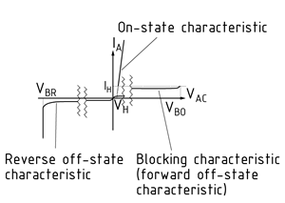
一种定义
四种语言
0,1,2
- 德國
- 英語
- 中國
- 西班牙語
Thyristor

Thyristors are switchable semi-Conductor valves. In Power electronics, thyristors are primarily used to control electric drives. They are utilised when high switching capacities (up to approx. 100,000 kVA) are needed at low frequencies.
In the positive control direction, there are two characteristic curves - the blocking characteristic and the on-state characteristic. When a cathode-anode voltage ${U_{AC}}$ (without gate signal) is applied, the thyristor first goes to the blocking characteristic. As soon as the gate signal is sufficiently positive, the thyristor instantly switches to the on-state characteristic and remains there as long as the holding current ${I_H}$ is flowing. Failure to reach the holding current causes the thyristor to jump from the branch of the on-state characteristic to that of the blocking characteristic. Increasing the voltage ${V_{AC}}$above the permissible maximum value with a blocked thyristor also causes ignition $({{\rm{V}}_{B0}})$. However, the component is not designed for this type of ignition and may be destroyed.
The reverse off-state characteristic is essentially the same as that of a Diode. Here, too, care needs to be taken not to exceed the breakdown voltage ${V_{BR}}$.
